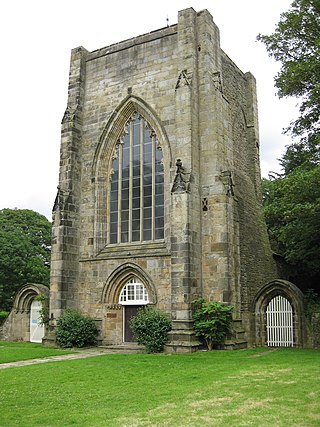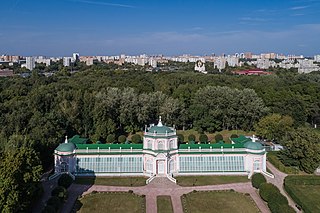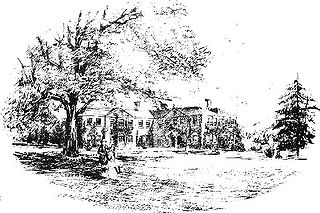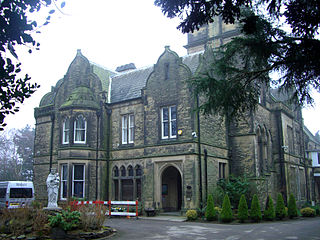
Bretton Hall is a country house in West Bretton near Wakefield, West Yorkshire, England. It housed Bretton Hall College from 1949 until 2001 and was a campus of the University of Leeds (2001–2007). It is a Grade II* listed building.

Beauchief Abbey is a medieval monastic house now serving as a parish church in the southern suburbs of Sheffield, England.

An orangery or orangerie was a room or a dedicated building on the grounds of fashionable residences of Northern Europe from the 17th to the 19th centuries where orange and other fruit trees were protected during the winter, as a very large form of greenhouse or conservatory.

Whirlow is a suburb of the City of Sheffield in England, it lies 3.7 miles (6 km) south-west of the city centre. The suburb falls within the Dore and Totley ward of the City. It is one of the most affluent areas of Sheffield, with much high class housing and several notable small country houses within it. During the Victorian era it was home to some of Sheffield's most influential citizens. Whirlow straddles the A625, the main Sheffield to Hathersage road. The suburb covers the area from Parkhead in the north to Whirlow Bridge in the south and from Ecclesall Woods in the east to Broad Elms Lane in the west. Whirlow had a population of 1,663 in 2011.

Heaton Park is a public park in Manchester, England, covering an area of over 600 acres (242.8 ha). The park includes the grounds of a Grade I listed, neoclassical 18th century country house, Heaton Hall. The hall, remodelled by James Wyatt in 1772, is now only open to the public on an occasional basis as a museum and events venue. It is the biggest park in Greater Manchester, and also the largest municipal park in Europe.

John Carr (1723–1807) was a prolific English architect, best known for Buxton Crescent in Derbyshire and Harewood House in West Yorkshire. Much of his work was in the Palladian style. In his day he was considered to be the leading architect in the north of England.

Caversham Park is a Victorian-era stately home with parkland in the suburb of Caversham on the outskirts of Reading, England. Historically located in Oxfordshire, it became part of Berkshire with boundary changes in 1911. Caversham Park was home to BBC Monitoring and BBC Radio Berkshire. The park is listed as Grade II in the English Heritage Register of Historic Parks and Gardens.
Middlewood is a north western suburb of Sheffield, South Yorkshire, England. The suburb falls within the Stannington ward of the City.

Thornbridge Hall is a large English country house situated near the village of Great Longstone in the local government district of Derbyshire Dales in Derbyshire. It is a Grade II listed building.

Longley is a suburb of the City of Sheffield, in South Yorkshire, England. It lies four km north of the city centre and is a residential neighbourhood made up mostly of housing built by Sheffield City Council in the late 1920s. The suburb falls within the Firth Park ward of the City.

The Jessop Hospital for Women was a hospital in Sheffield, South Yorkshire, England. At the time of its closure in 2001, it was managed by the Central Sheffield University Hospitals NHS Trust.

Hillsborough House, later called Hillsborough Hall, is a large, stone-built mansion constructed in the Adam style in the latter part of the 18th century. It stands 2+1⁄2 miles north-west of the centre of Sheffield at grid reference SK331901 in the suburb of Hillsborough within Hillsborough Park, a council-owned public recreational area. For 124 years the house was a private dwelling, but since 1906 it has housed the Hillsborough branch library. It is a Grade II listed building as are the coach house and stables which stand 22 yards (20 m) north-west of the main house.

The Globe Works are a former cutlery factory situated in the City of Sheffield, South Yorkshire, England on Penistone Road in the suburb of Neepsend. The Works are a Grade II* Listed Building which in the late 1980s were renovated to provide modern office space. It is part of the Kelham Island Conservation Area.

Endcliffe Hall is a 19th-century, 36-room mansion situated on Endcliffe Vale Road in the City of Sheffield in the suburb of Endcliffe. The hall is situated just over 2 miles (3.2 km) west of the city centre and is a Grade II* Listed building.

Oakes Park is a privately owned, historic park land in the green-belt area of south Sheffield. It contains 15 private homes as well as a 17th-century English country house which now operates as The Oakes Holiday Centre, a Christian, residential activity centre for young people between the ages of 8 and 18. It is set in extensive grounds which make it very difficult to be seen by the general public. It is situated on Norton Lane in the suburb of Norton within the City of Sheffield in England. The house is a Grade II* listed building, as are several other buildings and features.
Gleadless Valley is a housing estate and electoral ward of the City of Sheffield in England. The population of the ward at the 2011 Census was 21,089. It lies 2.5 miles (4.0 km) south-southeast of the city centre. Formerly a rural area, Gleadless Valley was developed as a large housing project with around 4000 dwellings by Sheffield City Council between 1955 and 1962. It is an area of undulating land drained by the Meers Brook, which has its source on the high ground in the woodland at Gleadless. Adjacent are Gleadless to the east, Norton to the south-west, Heeley to the west and Arbourthorne to the north.

Riverdale House is a Victorian mansion located at 89 Graham Road in the Ranmoor area of Sheffield, England. Formerly a private residence, the building, which is Grade II Listed has now been adopted for commercial use and accommodates several small businesses.

Mylnhurst is a small English country house on Button Hill in the Ecclesall area of Sheffield, England. The house was previously a private residence, it now serves as a private school. The house along with the attached stables and lodge are Grade II listed buildings.

Chalfont Park, formerly known as Brudenells and Bulstrodes, is an English country house and estate near the village of Chalfont St Peter in Buckinghamshire.

John Dodsley Webster FRIBA (1840–1913) was an English architect who designed more than 15 churches in Sheffield in various Gothic styles, usually working to a tight budget. His work also included hospitals and commercial buildings, small country houses and private houses. All his known work was carried out in the South Yorkshire and North Derbyshire area except for a chapel and school built in Coventry.




















